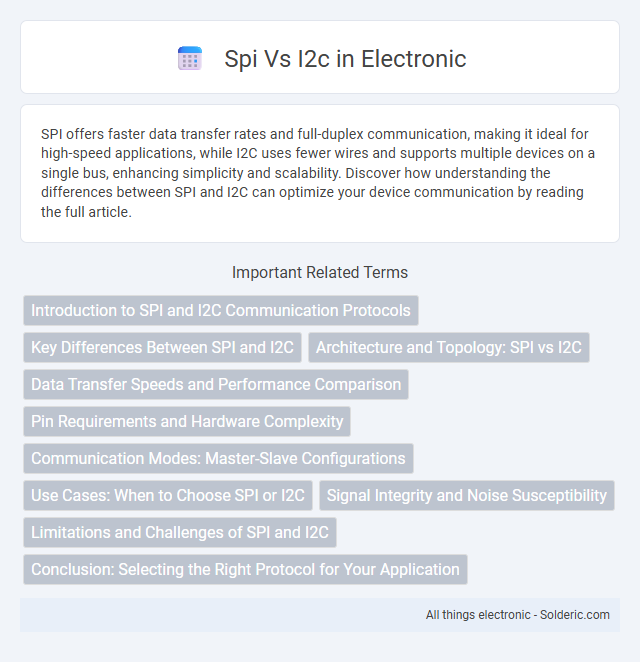SPI offers faster data transfer rates and full-duplex communication, making it ideal for high-speed applications, while I2C uses fewer wires and supports multiple devices on a single bus, enhancing simplicity and scalability. Discover how understanding the differences between SPI and I2C can optimize your device communication by reading the full article.
Comparison Table
| Feature | SPI (Serial Peripheral Interface) | I2C (Inter-Integrated Circuit) |
|---|---|---|
| Communication Type | Full-Duplex | Half-Duplex |
| Number of Wires | 4 (MOSI, MISO, SCLK, SS) | 2 (SDA, SCL) |
| Speed | Up to 50 Mbps (depends on implementation) | Typically up to 5 Mbps (Fast-mode Plus) |
| Number of Devices | Multiple Slaves, separate SS per device | Multiple Slaves, shared bus addressing |
| Data Transfer | Byte or word-oriented | Byte-oriented with acknowledgment |
| Bus Complexity | More wires, simpler protocol | Less wires, complex protocol with arbitration |
| Use Cases | High-speed sensors, memory devices | Low-speed peripherals, sensors, EEPROMs |
| Addressing | No addressing, SS line selects slave | 7 or 10-bit addressing on bus |
Introduction to SPI and I2C Communication Protocols
SPI (Serial Peripheral Interface) and I2C (Inter-Integrated Circuit) are widely used communication protocols in embedded systems for data exchange between microcontrollers and peripherals. SPI operates with a full-duplex, master-slave architecture using separate lines for data in, data out, clock, and chip select, enabling high-speed data transfer. I2C uses a two-wire, half-duplex bus with a single data line and clock, allowing multiple devices to share the same bus with unique addresses, making it your efficient choice for simpler, lower-speed communication over short distances.
Key Differences Between SPI and I2C
SPI uses separate lines for data in, data out, clock, and chip select, allowing full-duplex communication at higher speeds compared to I2C's two-wire, half-duplex design consisting of a data and clock line. I2C supports multiple devices with unique addresses on the same bus, simplifying wiring but limiting speed to typically 100 kbps to 400 kbps, whereas SPI's speed can exceed several Mbps due to its point-to-point connections. The complexity of SPI hardware implementation is higher because each device requires a dedicated chip select line, while I2C's hardware overhead is lower, making it better suited for multi-device, low-speed communication scenarios.
Architecture and Topology: SPI vs I2C
SPI features a full-duplex, master-slave architecture with separate lines for clock (SCLK), master out slave in (MOSI), master in slave out (MISO), and chip select (CS), enabling high-speed, synchronous data transfer. I2C uses a half-duplex, multi-master, multi-slave topology with only two bidirectional lines: serial data (SDA) and serial clock (SCL), allowing multiple devices to share the same bus through unique addressing. Your choice between SPI and I2C depends on the required data transfer speed, complexity, and the number of devices in your system.
Data Transfer Speeds and Performance Comparison
SPI offers significantly higher data transfer speeds than I2C, supporting clock rates up to 50 MHz or more, making it ideal for high-performance applications requiring fast communication. I2C typically operates at speeds up to 3.4 MHz (High-Speed mode), which provides adequate performance for slower peripheral devices but lags behind SPI in throughput. Your choice between SPI and I2C should consider device speed requirements and bus complexity, as SPI's full-duplex communication and simpler protocol enable faster and more efficient data exchange.
Pin Requirements and Hardware Complexity
SPI requires more pins, typically four--MISO, MOSI, SCLK, and SS--for full-duplex communication, increasing hardware complexity compared to I2C's two-wire interface consisting of SDA and SCL lines. This makes SPI ideal for applications needing high-speed data transfer and multiple slave devices but demands more PCB space and careful signal routing. Your choice depends on balancing pin availability against the required communication speed and complexity of the hardware design.
Communication Modes: Master-Slave Configurations
SPI supports full-duplex communication with one master and multiple slave devices, allowing simultaneous data transmission and reception on separate lines. I2C uses half-duplex communication in a multi-master, multi-slave setup, where devices communicate over a shared two-wire bus using unique addresses for each slave. Your choice between SPI and I2C significantly impacts communication speed, complexity, and wiring based on the master-slave configuration needs.
Use Cases: When to Choose SPI or I2C
SPI is ideal for high-speed communication and applications requiring full-duplex data transfer, such as memory cards, sensors, and displays. I2C suits low-speed, low-power use cases with multiple devices on the same bus, like temperature sensors and EEPROMs in embedded systems. You should choose SPI when data rate and simplicity matter, while I2C excels in complex, multi-device environments with limited wiring.
Signal Integrity and Noise Susceptibility
SPI offers superior signal integrity due to its full-duplex communication and separate lines for data and clock, minimizing crosstalk and signal degradation. I2C, with its open-drain configuration and shared bus lines, is more susceptible to noise and requires careful pull-up resistor selection to maintain signal quality. You should consider SPI for high-speed, noise-sensitive environments and I2C for simpler, low-speed applications where occasional noise is manageable.
Limitations and Challenges of SPI and I2C
SPI faces limitations such as the need for multiple chip select lines, which complicates wiring in systems with many devices, and lacks standardized flow control, increasing the risk of data collision. I2C encounters challenges with limited bus speed (typically up to 400 kbps or 1 Mbps in fast mode) and a maximum bus length constrained by capacitance, affecting signal integrity. Your choice should consider these constraints, balancing speed, complexity, and communication robustness for optimal performance.
Conclusion: Selecting the Right Protocol for Your Application
Choosing between SPI and I2C depends on your application's requirements for speed, complexity, and device count. SPI offers higher data transfer rates and is ideal for applications needing fast communication with multiple devices using dedicated lines. I2C simplifies wiring with its two-wire design, supports multiple devices using addresses, and excels in low-speed, low-power situations where minimizing pin usage is crucial.
spi vs i2c Infographic

 solderic.com
solderic.com